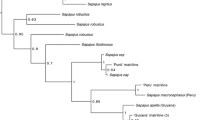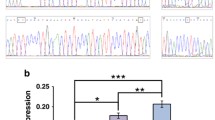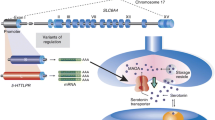Abstract
The serotonin transporter gene (SLC6A4) is heavily involved in the regulation of social behaviour of primates. Old World monkeys (e.g. macaques, baboons) have been used to study interactions between variation in the SLC6A4 gene and behaviour. Correlations of variation at one polymorphism located in the promoter region (known as 5HTTLPR) and variation at SLC6A4 expression levels, serotonin turnover and behaviour has been widely studied. In Old World monkeys, the third intron of the SLC6A4 gene also presents a tandem repeat, which sequence varies across species by a few point substitutions. We predict that in these species, this repeated region also acts as transcriptional regulatory domain and that sequence variation at this polymorphic locus might result in differential levels of expression in gene–environment interactions. For testing these hypotheses, the tandem repeat of Mandrillus sphinx and Cercopithecus aethiops from the third intron were cloned into a reporter gene vector and delivered to either primary cultures of rat neonate frontal cortex or the human cell line (JAr) to analyse their transcriptional activities. These repeated sequences supported significantly different levels of gene expression only when delivered into frontal cortex cultures. Furthermore, we tested in silico if such substitutions could have an effect on their binding profile to RNA- and DNA-binding proteins and on splicing. Taken together our results suggest that the tandem repeat in the third intron of the SLC6A4 gene of Old World monkeys could constitute a second transcriptional regulator as suggested for the 5HTTLPR and therefore contribute to diversification of serotonin-related behaviour in these primates.


Similar content being viewed by others
References
Ali FR, Vasiliou SA, Haddley K, Paredes UM, Roberts JC, Miyajima F, Klenova E, Bubb VJ, Quinn JP (2010) Combinatorial interaction between two human serotonin transporter gene variable number tandem repeats and their regulation by CTCF. J Neurochem 112(1):296–306
Battersby S, Ogilvie AD, Smith CA, Blackwood DH, Muir WJ, Quinn JP, Fink G, Goodwin GM, Harmar AJ (1996) Structure of a variable number tandem repeat of the serotonin transporter gene and association with affective disorder. Psychiatr Genet 6(4):177–181
Bell GI, Jurka J (1997) The length distribution of perfect dimer repetitive DNA is consistent with its evolution by an unbiased single-step mutation process. J Mol Evol 44(4):414–421
Chomczynski P, Sacchi N (1987) Single-step method of RNA isolation by acid guanidinium thiocyanate–phenol–chloroform extract. Anal Biochem 162(1):156–159
Fairbanks LA, Jorgensen MJ, Huff A, Blau K, Hung YY, Mann JJ (2004a) Adolescent impulsivity predicts adult dominance attainment in male vervet monkeys. Am J Primatol 64:1–17
Fairbanks LA, Newman TK, Bailey JN, Jorgensen MJ, Breidenthal SE, Ophoff RA, Comuzzie AG, Martin LJ, Rogers J (2004b) Genetic contributions to social impulsivity and aggressiveness in vervet monkeys. Biol Psychiatry 55(6):642–647
Faustino NA, Cooper TA (2003) Pre mRNA splicing and human disease. Genes Dev 17:419–437
Fiskerstrand CE, Lovejoy EA, Quinn JP (1999) An intronic polymorphic domain often associated with susceptibility to affective disorders has allele dependent differential enhancer activity in embryonic stem cells. FEBS Lett 458(2):171–174
Gabellini N (2001) A polymorphic GT repeat from the human cardiac Na+Ca2+ exchanger intron 2 activates splicing. Eur J Biochem 268(4):1076–1083
Gelernter J, Cubells JF, Kidd JR, Pakstis AJ, Kidd KK (1999) Population studies of polymorphisms of the serotonin transporter protein gene. Am J Med Genet 88:61–66
Giresi PG, Lieb JD (2009) Isolation of active regulatory elements from eukaryotic chromatin using FAIRE (Formaldehyde Assisted Isolation of Regulatory Elements). Methods 48(3):233–239
Goren A, Ram O, Amit M, Keren H, Lev-Maor G, Vig I, Pukpo T, Ast G (2006) Comparative analysis identifies exonic splicing regulatory sequences—the complex definition of enhancers and silencers. Mol Cell 22(6):769–781
Haddley K, Vasiliou AS, Ali FR, Paredes UM, Bubb VJ, Quinn JP (2008) Molecular genetics of monoamine transporters: relevance to brain disorders. Neurochem Res 33(4):652–670
Han DH, Park DB, Na C, Kee BS, Lee YS (2004) Association of aggressive behavior in Korean male schizophrenic patients with polymorphisms in the serotonin transporter promoter and catecholamine-O-methyltransferase genes. Psychiatry Res 129(1):29–37
Hariri AR, Mattay VS, Tessitore A, Kolachana B, Fera F, Goldman D, Egan MF, Weinberger DR (2002) Serotonin transporter genetic variation and the response of the human amygdala. Science 297(5580):400–403
Heinz A, Higley JD, Gorey JG, Saunders RC, Jones DW, Hommer D, Zajicek K, Suomi SJ, Lesch KP, Weinberger DR, Linnoila M (1998) In vivo association between alcohol intoxication, aggression, and serotonin transporter availability in nonhuman primates. Am J Psychiatry 155:1023–1028
Heinz A, Jones DW, Mazzanti C, Goldman D, Ragan P, Hommer D, Linnoila M, Weinberger DR (2000) A relationship between serotonin transporter genotype and in vivo protein expression and alcohol neurotoxicity. Biol Psychiatry 47(7):643–649
Heinz A, Jones DW, Gorey JG, Bennet A, Suomi SJ, Weinberger DR, Higley JD (2003) Serotonin transporter availability correlates with alcohol intake in non-human primates. Mol Psychiatry 8:231–234
Higley JD, Suomi SJ, Linnoila M (1996) A nonhuman primate model of type II excessive alcohol consumption? Part 1. Low cerebrospinal fluid 5-hydroxyindoleacetic acid concentrations and diminished social competence correlate with excessive alcohol consumption. Alcohol Clin Exp Res 20(4):629–642
Hranilovic D, Stefulj J, Schwab S, Borrmann-Hassenbach M, Albus M, Jernej B, Wildenauer D (2004) Serotonin transporter promoter and intron 2 polymorphisms: relationship between allelic variants and gene expression. Biol Psychiatry 55(11):1090–1094
Inoue-Murayama M, Hibino E, Iwatsuki H, Inoue E, Hong KW, Nishida T, Hayasaka I, Ito S, Murayama Y (2008) Interspecies and intraspecies variations in the serotonin transporter gene intron 3 VNTR in nonhuman primates. Primates 49(2):139–142
Izquierdo A, Newman TK, Higley JD, Murray EA (2007) Genetic modulation of cognitive flexibility and socioemotional behavior in rhesus monkeys. Proc Natl Acad Sci U S A 104(35):14128–14133
Kaplan J, Fontenot MB, Berard J, Manuck SB, Mann JJ (1995) Delayed dispersal and elevated monoaminergic activity in free-ranging rhesus monkeys. Am J Primatol 35(3):229–234
Kaplan JR, Phillips-Conroy J, Fontenot MB, Jolly CJ, Fairbanks LA, Mann JJ (1999) Cerebrospinal fluid monoaminergic metabolites differ in wild anubis and hybrid (Anubis hamadryas) baboons: possible relationships to life history and behavior. Neuropsychopharmacol 20(6):517–524
Kaplan JR, Manuck SB, Fontenot MB, Mann JJ (2002) Central nervous system monoamine correlates of social dominance in cynomolgus monkeys (Macaca fascicularis). Neuropsychopharmacol 26(4):431–443
Klenova E, Scott AC, Roberts J, Shamsuddin S, Lovejoy EA, Bergmann S, Bubb VJ, Royer HD, Quinn JP (2004) YB-1 and CTCF differentially regulate the 5-HTT polymorphic intron 2 enhancer which predisposes to a variety of neurological disorders. J Neurosci 24(26):5966–5973
MacKenzie A, Quinn JP (1999) A serotonin transporter gene intron 2 polymorphic region, correlated with affective disorders, has allele-dependent differential enhancer-like properties in the mouse embryo. Proc Natl Acad Sci U S A 96(26):15251–15255
MacKenzie A, Quinn JP (2004) Post-genomic approaches to exploring neuropeptide gene mis-expression in disease. Neuropeptides 38(1):1–15
Mehlman PT, Higley JD, Faucher I, Lilly AA, Taub DM, Vickers J, Suomi SJ, Linnoila M (1995) Correlation of CSF 5-HIAA concentration with sociality and the timing of emigration in free-ranging primates. Am J Psychiatry 152:907–913
Moore TM, Scarpa A, Raine A (2002) A meta-analysis of serotonin metabolite 5-HIAA and antisocial behavior. Aggressive Behav 28(4):299–316
Ogilvie AD, Battersby S, Bubb VJ, Fink G, Harmar AJ, Goodwim GM, Smith CA (1996) Polymorphism in serotonin transporter gene associated with susceptibility to major depression. Lancet 347(9003):731–733
Paredes UM, Bubb VJ, Haddley K, Macho GA, Quinn JP (2011) An evolutionary conserved region in the human dopamine receptor D4 gene supports reporter gene expression in primary cultures derived from the rat cortex. BMC Neurosci 12:46
Rogers J, Martin LJ, Comuzzie AG, Mann JJ, Manuck SB, Leland M, Kaplan JR (2004) Genetics of monoamine metabolites in baboons: overlapping sets of genes influence levels of 5-hydroxyindolacetic acid, 3-hydroxy-4-methoxyphenylglycol, and homovanillic acid. Biol Psychiatry 55(7):739–744
Sakai K, Nakamura M, Ueno S, Sano A, Sakai N, Shirai Y, Saito N (2002) The silencer activity of the novel human serotonin transporter linked polymorphic regions. Neurosci Lett 327(1):13–16
Soeby K, Larsen SA, Olsen L, Rasmussen HB, Werge T (2005) Serotonin transporter: evolution and impact of polymorphic transcriptional regulation. Am J Med Genet B Neuropsychiatr Genet 136B:53–57
Spencer EM, Chandler KE, Haddley K, Howard MR, Hughes D, Belyaev ND, Coulson JM, Stewart JP, Buckley NJ, Kipar A, Walker MC, Quinn JP (2006) Regulation and role of REST and REST4 variants in modulation of gene expression in in vivo and in vitro in epilepsy models. Neurobiol Dis 24(1):41–52
Suomi SJ (2003) Gene–environment interactions and the neurobiology of social conflict. Ann N Y Acad Sci 1008:132–139
Trefilov A, Berard J, Krawczak M, Schmidtke J (2000) Natal dispersal in rhesus macaques is related to serotonin transporter gene promoter variation. Behav Genet 30(4):295–301
Tsai SJ, Ouyang WC, Hong CJ (2002) Association for serotonin transporter gene variable number tandem repeat polymorphism and schizophrenic disorders. Neuropsychobiology 45(3):131–133
Wendland JR, Lesch KP, Newman TK, Timme A, Gachot-Neveu H, Thierry B, Suomi SJ (2006) Differential functional variability of serotonin transporter and monoamine oxidase a genes in macaque species displaying contrasting levels of aggression-related behavior. Behav Genet 36(2):163–172
Yilmaz M, Erdal ME, Herken H, Cataloluk O, Barlas O, Bayazit YA (2001) Significance of serotonin transporter gene polymorphism in migraine. J Neurol Sci 186(1–2):27–30
Ying SY, Lin SL (2004) Intron-derived microRNAs—fine tuning of gene functions. Gene 342(1):25–28
Author information
Authors and Affiliations
Corresponding author
Rights and permissions
About this article
Cite this article
Paredes, U.M., Bubb, V.J., Haddley, K. et al. Intronic Tandem Repeat in the Serotonin Transporter Gene in Old World Monkeys: a New Transcriptional Regulator?. J Mol Neurosci 47, 401–407 (2012). https://doi.org/10.1007/s12031-011-9664-6
Received:
Accepted:
Published:
Issue Date:
DOI: https://doi.org/10.1007/s12031-011-9664-6




